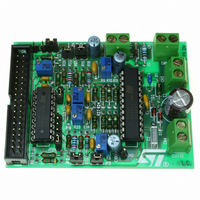EVAL6206N STMicroelectronics, EVAL6206N Datasheet - Page 17

EVAL6206N
Manufacturer Part Number
EVAL6206N
Description
EVAL BOARD FOR L6206N DIP
Manufacturer
STMicroelectronics
Specifications of EVAL6206N
Mfg Application Notes
PractiSPIN AppNote
Design Resources
EVAL6206N/6206N Gerber Files EVAL6206N Schematic/Bill of Materials
Main Purpose
Power Management, H Bridge Driver (Internal FET)
Embedded
No
Utilized Ic / Part
L6205N DIP
Primary Attributes
Dual Full-Bridge (H-Bridge), 2.8A (5.6A Peak). 8 ~ 52 V, 0.3 Ohm
Secondary Attributes
Non-Inverting, Can be Paralleled
Architecture
Analog
Applications
Motor Control
Processor To Be Evaluated
L6206
For Use With
497-4138 - EVALUATION BOARD PRACTISPIN
Lead Free Status / RoHS Status
Lead free / RoHS Compliant
Other names
497-5487
OUTPUT CURRENT CAPABILITY AND IC POWER DISSIPATION
In Fig. 16 and Fig. 17 are shown the approximate relation between the output current and the IC power dissipa-
tion using PWM current control driving two loads, for two different driving types:
– One Full Bridge ON at a time (Fig.16) in which only one load at a time is energized.
– Two Full Bridges ON at the same time (Fig.17) in which two loads at the same time are energized.
For a given output current and driving type the power dissipated by the IC can be easily evaluated, in order to
establish which package should be used and how large must be the on-board copper dissipating area to guar-
antee a safe operating junction temperature (125°C maximum).
Figure 16. IC Power Dissipation versus Output Current with One Full Bridge ON at a time.
Figure 17. IC Power Dissipation versus Output Current with Two Full Bridges ON at the same time.
THERMAL MANAGEMENT
In most applications the power dissipation in the IC is the main factor that sets the maximum current that can be de-
liver by the device in a safe operating condition. Therefore, it has to be taken into account very carefully. Besides the
available space on the PCB, the right package should be chosen considering the power dissipation. Heat sinking can
be achieved using copper on the PCB with proper area and thickness. Figures 19, 20 and 21 show the Junction-to-
Ambient Thermal Resistance values for the PowerSO36, PowerDIP24 and SO24 packages.
For instance, using a PowerSO package with copper slug soldered on a 1.5 mm copper thickness FR4 board
with 6cm
ing methods for this package. Using a multi-layer board with vias to a ground plane, thermal impedance can be
reduced down to 15°C/W.
2
dissipating footprint (copper thickness of 35µm), the R
P
P
D
D
TWO FULL BRIDGES ON AT THE SAME TIME
[W]
[W ]
10
8
6
4
2
0
10
8
6
4
2
0
0
ONE FULL BRIDGE ON AT A TIME
0
0.5
0.5
1
1
I
OUT
I
OUT
1.5
1.5
[A]
[A ]
2
2
2.5
2.5
3
3
I
I
A
B
I
I
A
B
th j-amb
Test Conditions:
Supply Voltage = 24V
Test Conditions:
Supply Voltage = 24V
I
OUT
I
OUT
is about 35°C/W. Fig. 18 shows mount-
No PWM
f
SW
I
No PWM
f
OUT
= 30kHz (slow decay)
SW
= 30kHz (slow decay)
I
OUT
L6206
17/23












